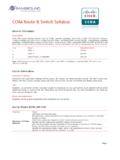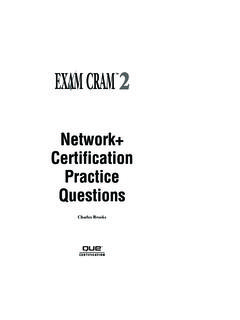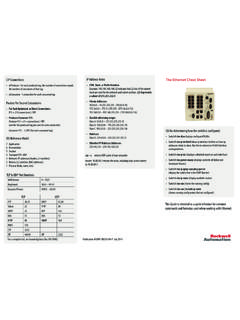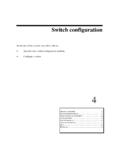Transcription of CHAPTER THREE Networking Components and …
1 3 CHAPTER THREEN etworking Componentsand , configure and differentiate between common network access DHCP the functions of specialized network network 3: Networking Components and the advanced features of a authenticationWhat You Need To how hubs and switches how hubs and switches can be connected to create larger how bridges, routers, and gateways how routing protocols are used for dynamic the purpose of other Networking Components , such as Channel Service Unit/DataService Unit (CSU/DSU) and the purpose and function of network the purpose of a but the most basic of networks require devices to provide connectivity andfunctionality. Understanding how these Networking devices operate and identi-fying the functions they perform are essential skills for any network administra-tor and are requirements for a Network+ CHAPTER introduces commonly used Networking devices.
2 Although it is truethat you are not likely to encounter all the devices mentioned in this CHAPTER onthe exam, you can be assured of working with at least some of the bottom of the Networking food chain, so to speak, are hubs . hubs areused in networks that use twisted-pair cabling to connect devices. hubs also canbe joined to create larger networks. Hubsare simple devices that direct datapackets to all devices connected to the hub, regardless of whether the data pack-age is destined for the device. This makes them inefficient devices and can cre-ate a performance bottleneck on busy its most basic form, a hub does nothing except provide a pathway for the elec-trical signals to travel along.
3 Such a device is called a passivehub. Far more com-mon nowadays is an activehub, which, as well as providing a path for the datasignals, regenerates the signal before it forwards it to all the connected addition, an active hub can buffer data before forwarding it. However, a hubdoes not perform any processing on the data it forwards, nor does it perform anyerror come in a variety of shapes and sizes. Small hubs with five or eight con-nection ports are commonly called workgroup hubs . Others can accommodatelarger numbers of devices (normally up to 32). These are called high-densitydevices. Because hubs don t perform any processing, they do little except enablecommunication between connected devices.
4 For today s high-demand networkapplications, something with a little more intelligence is required. That s whereswitches come a token ring network, a multistation access unit (MSAU) is used in place ofthe hub that is used on an Ethernet network. The MSAU performs the tokencirculation inside the device, giving the network a physical star appearance. Itfunctions as a logical ring. The logical ring function is performed from withinthe MSAU. Each MSAU has a ring in (RI) port on the device, which is connect-ed to the ring out (RO) port on another MSAU. The last MSAU in the ring isthen connected to the first to complete the ring. Because token ring networksare few and far between nowadays, it is far more likely that you will find your-self working with Ethernet hubs and access unit is sometimes written as MSAU, but it is commonly called acronyms are ALERTEven though MSAU and token ring networks are not common, you can expect a fewquestions on them on the 3: Introduction to NetworkingSwitchesLike hubs , switchesare the connectivity points of an Ethernet network.
5 Devicesconnect to switches via twisted-pair cabling, one cable for each device. The dif-ference between hubs and switches is in how the devices deal with the data theyreceive. Whereas a hub forwards the data it receives to all the ports on thedevice, a switch forwards it to only the port that connects to the destinationdevice. It does this by learningthe MAC address of the devices attached to it andthen by matching the destination MAC address in the data it receives. Figure how a switch sent byone nodeData is forwardedonly to thedestination nodeSwitchFIGURE a switch forwarding data to only the connection that should receive it, the switch cangreatly improve network performance.
6 By creating a direct path between twodevices and controlling their communication, the switch can greatly reduce thetraffic on the network and therefore the number of collisions. As you mightrecall, collisions occur on Ethernet networks when two devices attempt to trans-mit at exactly the same time. In addition, the lack of collisions enables switchesto communicate with devices in full-duplex mode. In a full-duplex configura-tion, devices can send data to and receive data from the switch at the same this with half-duplex communication, in which communication canoccur in only one direction at a time. Full-duplex transmission speeds are dou-ble that of a standard half-duplex connection.
7 So, a 10 Mbps connection becomes20 Mbps, and a 100 Mbps connection becomes net result of these measures is that switches can offer significant performanceimprovements over hub-based networks, particularly when network use is of whether a connection is at full or half duplex, the method ofswitching dictates how the switch deals with the data it receives. The followingis a brief explanation of each method:.Cut-through: In a cut-through switching environment, the packetbegins to be forwarded as soon as it is received. This method is very fast,Switches99but it creates the possibility of errors being propagated through the net-work, because no error checking : Unlike cut-through, in a store-and-forward switch-ing environment, the entire packet is received and error-checked beforebeing forwarded.
8 The upside of this method is that errors are not propa-gated through the network. The downside is that the error-checkingprocess takes a relatively long time, and store-and-forward switching isconsiderably slower as a : To take advantage of the error checking of store-and-forward switching, but still offer performance levels nearing that of cut-through switching, FragmentFree switching can be used. In aFragmentFree-switching environment, enough of the packet is read sothat the switch can determine whether the packet has been involved in acollision. As soon as the collision status has been determined, the packetis and Switch CablingIn addition to acting as a connection point for network devices, hubs and switch-es can be connected to create larger networks.
9 This connection can be achievedthrough standard ports with a special cable or by using special ports with a stan-dard ports on a hub to which computer systems are attached are called Medium-Dependent Interface Crossed (MDI-X).The crossed designation is derived fromthe fact that two of the wires within the connection are crossed so that the sendsignal wire on one device becomes the receive signal of the other. Because theports are crossed internally, a standard or straight-throughcable can be used toconnect type of port, called a Medium-Dependent Interface (MDI)port, is oftenincluded on a hub or switch to facilitate the connection of two switches or the hubs or switches are designed to see each other as simply an exten-sion of the network, there is no need for the signal to be crossed.
10 If a hub orswitch does not have an MDI port, hubs or switches can be connected by usinga crossovercable between two MDI-X ports. The crossover cable uncrosses theinternal crossing. Crossover cables are discussed in CHAPTER 2, Cabling,Connectors, and Ethernet Standards. 100 CHAPTER 3: Introduction to NetworkingBridgesBridgesare used to divide larger networks into smaller sections. Bridges accom-plish this by sitting between two physical network segments and managing theflow of data between the two. By looking at the MAC address of the devices con-nected to each segment, bridges can elect to forward the data (if they believethat the destination address is on another interface) or block it from crossing (ifthey can verify that it is on the interface from which it came).








